Haiguang Liao
Hierarchical Automatic Power Plane Generation with Genetic Optimization and Multilayer Perceptron
Nov 02, 2022Abstract:We present an automatic multilayer power plane generation method to accelerate the design of printed circuit boards (PCB). In PCB design, while automatic solvers have been developed to predict important indicators such as the IR-drop, power integrity, and signal integrity, the generation of the power plane itself still largely relies on laborious manual methods. Our automatic power plane generation approach is based on genetic optimization combined with a multilayer perceptron and is able to automatically generate power planes across a diverse set of problems with varying levels of difficulty. Our method GOMLP consists of an outer loop genetic optimizer (GO) and an inner loop multi-layer perceptron (MLP) that generate power planes automatically. The critical elements of our approach include contour detection, feature expansion, and a distance measure to enable island-minimizing complex power plane generation. We compare our approach to a baseline solution based on A*. The A* method consisting of a sequential island generation and merging process which can produce less than ideal solutions. Our experimental results show that on single layer power plane problems, our method outperforms A* in 71% of the problems with varying levels of board layout difficulty. We further describe H-GOMLP, which extends GOMLP to multilayer power plane problems using hierarchical clustering and net similarities based on the Hausdorff distance.
Placement in Integrated Circuits using Cyclic Reinforcement Learning and Simulated Annealing
Nov 15, 2020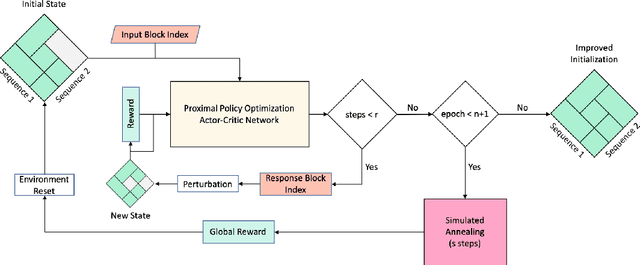



Abstract:Physical design and production of Integrated Circuits (IC) is becoming increasingly more challenging as the sophistication in IC technology is steadily increasing. Placement has been one of the most critical steps in IC physical design. Through decades of research, partition-based, analytical-based and annealing-based placers have been enriching the placement solution toolbox. However, open challenges including long run time and lack of ability to generalize continue to restrict wider applications of existing placement tools. We devise a learning-based placement tool based on cyclic application of Reinforcement Learning (RL) and Simulated Annealing (SA) by leveraging the advancement of RL. Results show that the RL module is able to provide a better initialization for SA and thus leads to a better final placement design. Compared to other recent learning-based placers, our method is majorly different with its combination of RL and SA. It leverages the RL model's ability to quickly get a good rough solution after training and the heuristic's ability to realize greedy improvements in the solution.
Track-Assignment Detailed Routing Using Attention-based Policy Model With Supervision
Oct 26, 2020
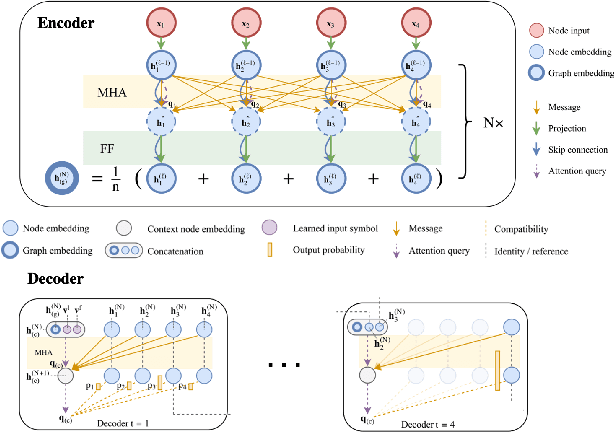

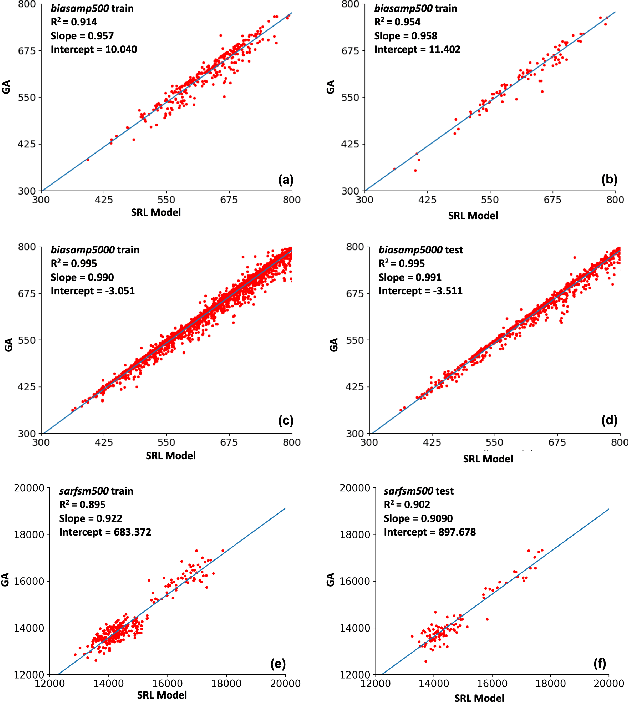
Abstract:Detailed routing is one of the most critical steps in analog circuit design. Complete routing has become increasingly more challenging in advanced node analog circuits, making advances in efficient automatic routers ever more necessary. In this work, we propose a machine learning driven method for solving the track-assignment detailed routing problem for advanced node analog circuits. Our approach adopts an attention-based reinforcement learning (RL) policy model. Our main insight and advancement over this RL model is the use of supervision as a way to leverage solutions generated by a conventional genetic algorithm (GA). For this, our approach minimizes the Kullback-Leibler divergence loss between the output from the RL policy model and a solution distribution obtained from the genetic solver. The key advantage of this approach is that the router can learn a policy in an offline setting with supervision, while improving the run-time performance nearly 100x over the genetic solver. Moreover, the quality of the solutions our approach produces matches well with those generated by GA. We show that especially for complex problems, our supervised RL method provides good quality solution similar to conventional attention-based RL without comprising run time performance. The ability to learn from example designs and train the router to get similar solutions with orders of magnitude run-time improvement can impact the design flow dramatically, potentially enabling increased design exploration and routability-driven placement.
Attention Routing: track-assignment detailed routing using attention-based reinforcement learning
Apr 20, 2020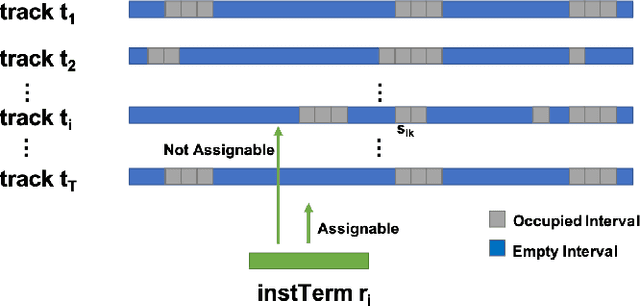
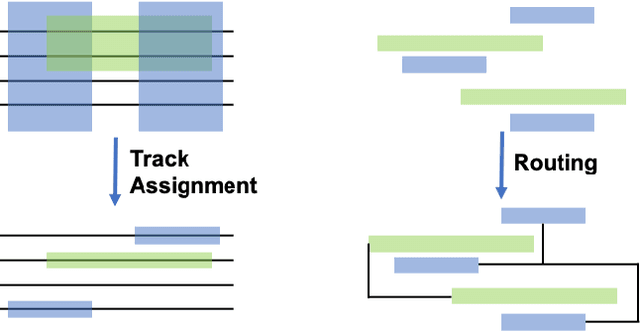


Abstract:In the physical design of integrated circuits, global and detailed routing are critical stages involving the determination of the interconnected paths of each net on a circuit while satisfying the design constraints. Existing actual routers as well as routability predictors either have to resort to expensive approaches that lead to high computational times, or use heuristics that do not generalize well. Even though new, learning-based routing methods have been proposed to address this need, requirements on labelled data and difficulties in addressing complex design rule constraints have limited their adoption in advanced technology node physical design problems. In this work, we propose a new router: attention router, which is the first attempt to solve the track-assignment detailed routing problem using reinforcement learning. Complex design rule constraints are encoded into the routing algorithm and an attention-model-based REINFORCE algorithm is applied to solve the most critical step in routing: sequencing device pairs to be routed. The attention router and its baseline genetic router are applied to solve different commercial advanced technologies analog circuits problem sets. The attention router demonstrates generalization ability to unseen problems and is also able to achieve more than 100 times acceleration over the genetic router without significantly compromising the routing solution quality. We also discover a similarity between the attention router and the baseline genetic router in terms of positive correlations in cost and routing patterns, which demonstrate the attention router's ability to be utilized not only as a detailed router but also as a predictor for routability and congestion.
A Deep Reinforcement Learning Approach for Global Routing
Jun 20, 2019


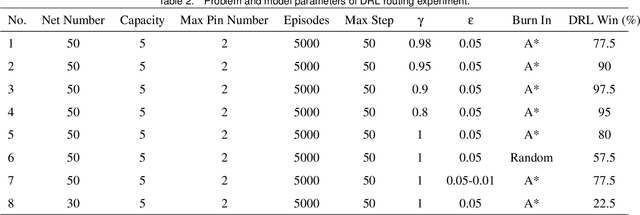
Abstract:Global routing has been a historically challenging problem in electronic circuit design, where the challenge is to connect a large and arbitrary number of circuit components with wires without violating the design rules for the printed circuit boards or integrated circuits. Similar routing problems also exist in the design of complex hydraulic systems, pipe systems and logistic networks. Existing solutions typically consist of greedy algorithms and hard-coded heuristics. As such, existing approaches suffer from a lack of model flexibility and non-optimum solutions. As an alternative approach, this work presents a deep reinforcement learning method for solving the global routing problem in a simulated environment. At the heart of the proposed method is deep reinforcement learning that enables an agent to produce an optimal policy for routing based on the variety of problems it is presented with leveraging the conjoint optimization mechanism of deep reinforcement learning. Conjoint optimization mechanism is explained and demonstrated in details; the best network structure and the parameters of the learned model are explored. Based on the fine-tuned model, routing solutions and rewards are presented and analyzed. The results indicate that the approach can outperform the benchmark method of a sequential A* method, suggesting a promising potential for deep reinforcement learning for global routing and other routing or path planning problems in general. Another major contribution of this work is the development of a global routing problem sets generator with the ability to generate parameterized global routing problem sets with different size and constraints, enabling evaluation of different routing algorithms and the generation of training datasets for future data-driven routing approaches.
 Add to Chrome
Add to Chrome Add to Firefox
Add to Firefox Add to Edge
Add to Edge